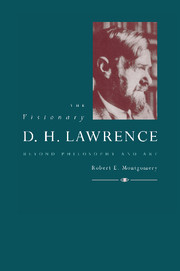Book contents
- Frontmatter
- Contents
- Acknowledgments
- 1 Introduction
- 2 Flesh, Word, and Holy Ghost: Lawrence and Schopenhauer
- 3 The passionate struggle into conscious being: Lawrence and Nietzsche
- 4 “A dry soul is best”: Lawrence and Heraclitus
- 5 The science of the soul: Lawrence and Boehme
- 6 Conclusion: Romanticism and Christianity
- Bibliography
- Index
6 - Conclusion: Romanticism and Christianity
Published online by Cambridge University Press: 08 January 2010
- Frontmatter
- Contents
- Acknowledgments
- 1 Introduction
- 2 Flesh, Word, and Holy Ghost: Lawrence and Schopenhauer
- 3 The passionate struggle into conscious being: Lawrence and Nietzsche
- 4 “A dry soul is best”: Lawrence and Heraclitus
- 5 The science of the soul: Lawrence and Boehme
- 6 Conclusion: Romanticism and Christianity
- Bibliography
- Index
Summary
For Lawrence the essential question was always: “How shall man put himself into relation to God, into a living relation” (Phoenix 726–27). Man is “related to the universe in some ‘religious’ way” (qtd. in Kalnins 19), but this way is constantly changing. Christianity once met the needs of man for a living contact with “this terrific and frightening and delighted potency I call Almighty God” (Apocalypse 155), but Lawrence in his youth found that Christianity in its present form was no longer able to meet his deepest needs, nor - he felt - the deepest needs of his civilization. He was preceded in this conviction by many of the Romantics, and it was to them that he turned after losing his faith. He followed the Romantics in his belief in art as another kind of religious experience:
And when our religious responses are dead, or inactive, we are really cut off from life, because the deepest part of our consciousness is not functioning. We try to take refuge in art. But to my mind, the essential feeling in all art is religious, and art is a form of religion without dogma. The feeling in art is religious, always. Whenever the soul is moved to a certain fullness of experience, that is religion. Every sincere and genuine feeling is a religious feeling. And the point of every work of art is that it achieves a state of feeling which becomes true experience, and so is religious.
(Apocalypse 155)- Type
- Chapter
- Information
- The Visionary D. H. LawrenceBeyond Philosophy and Art, pp. 218 - 230Publisher: Cambridge University PressPrint publication year: 1994



